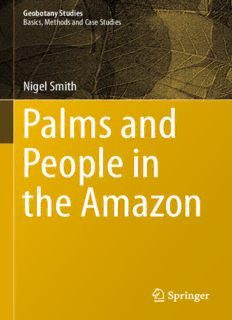
Palms and People in the Amazon PDF
Preview Palms and People in the Amazon
Geobotany Studies Basics, Methods and Case Studies Nigel Smith Palms and People in the Amazon Geobotany Studies Basics, Methods and Case Studies Editor FrancoPedrotti UniversityofCamerino Camerino Italy EditorialBoard S.Bartha,Vacratot,Hungary F.Bioret,UniversityofBrest,France E.O.Box,UniversityofGeorgia,Athens,USA A.Cˇarni,SlovenianAcademyofSciences,Ljubljana(Slovenia) K.Fujiwara,UniversityofYokohama,Japan D.Gafta,University“Babes-Bolyai”ofCluj-Napoca(Romania) J.-M.Ge´hu,Inter-Phyto,NouvionsurPonthieux,France J.Loidi,UniversityofBilbao,Spain L.Mucina,UniversityofPerth,Australia S.Pignatti,UniversityofRome,Italy R.Pott,UniversityofHannover,Germany A.Velasquez,CentrodeInvestigacionenScienciasAmbientales, Morelia,Mexico R.Venanzoni,UniversityofPerugia,Italy Moreinformationaboutthisseriesat http://www.springer.com/series/10526 About the Series The series includes outstanding monographs and collections of papers on a given topic in the following fields: Phytogeography, Phytosociology, Plant Community Ecology,Biocoenology,VegetationScience,Eco-informatics,LandscapeEcology, Vegetation Mapping, Plant Conservation Biology and Plant Diversity. Contributions are expected to reflect the latest theoretical and methodological developments or to present new applications at large spatial or temporal scales that could reinforce our understanding of ecological processes acting at the phytocoenosis and vegetation landscape level. Case studies based on large data sets are also considered, provided they support habitat classification refinement, plant diversity conservation or vegetation change prediction. Geobotany Studies: Basics, Methodsand Case Studies is the successor to Braun-Blanquetia published bytheUniversityofCamerinobetween1984and2011withcooperationofStation Internationale de Phytosociologie (Bailleul-France) and Dipartimento di Botanica ed Ecologia (Universite´ de Camerino - Italia) and under the aegis of Societe´ Amicale Francophone de Phytosociologie, Societe´ Francaise de Phytosociologie, Rheinold Tuexen Gesellschaft and the Eastern Alpine and Dinaric Society for Vegetation Ecology. This series aims to promote the expansion, evolution and applicationoftheinvaluablescientificlegacyoftheBraun-Blanquetiaschool. Nigel Smith Palms and People in the Amazon NigelSmith DepartmentofGeography UniversityofFlorida Gainesville,FL USA ISSN2198-2562 ISSN2198-2570(electronic) ISBN978-3-319-05508-4 ISBN978-3-319-05509-1(eBook) DOI10.1007/978-3-319-05509-1 SpringerChamHeidelbergNewYorkDordrechtLondon LibraryofCongressControlNumber:2014948187 #SpringerInternationalPublishingSwitzerland2015 Thisworkissubjecttocopyright.AllrightsarereservedbythePublisher,whetherthewholeorpart of the material is concerned, specifically the rights of translation, reprinting, reuse of illustrations, recitation,broadcasting,reproductiononmicrofilmsorinanyotherphysicalway,andtransmissionor informationstorageandretrieval,electronicadaptation,computersoftware,orbysimilarordissimilar methodologynowknownorhereafterdeveloped.Exemptedfromthislegalreservationarebriefexcerpts inconnectionwithreviewsorscholarlyanalysisormaterialsuppliedspecificallyforthepurposeofbeing enteredandexecutedonacomputersystem,forexclusiveusebythepurchaserofthework.Duplication ofthispublicationorpartsthereofispermittedonlyundertheprovisionsoftheCopyrightLawofthe Publisher’s location, in its current version, and permission for use must always be obtained from Springer.PermissionsforusemaybeobtainedthroughRightsLinkattheCopyrightClearanceCenter. ViolationsareliabletoprosecutionundertherespectiveCopyrightLaw. The use of general descriptive names, registered names, trademarks, service marks, etc. in this publicationdoesnotimply,evenintheabsenceofaspecificstatement,thatsuchnamesareexempt fromtherelevantprotectivelawsandregulationsandthereforefreeforgeneraluse. While the advice and information in this book are believed to be true and accurate at the date of publication,neithertheauthorsnortheeditorsnorthepublishercanacceptanylegalresponsibilityfor anyerrorsoromissionsthatmaybemade.Thepublishermakesnowarranty,expressorimplied,with respecttothematerialcontainedherein. Printedonacid-freepaper SpringerispartofSpringerScience+BusinessMedia(www.springer.com) TothememoryofHilgardO’ReillySternberg (1915–2011) Brazilian geographer, mentor, and inspiring teacher who introduced me to the Amazon in 1970 during a summer field course ThiSisaFMBlankPage Preface IhaveundertakenfieldworkintheAmazonsince1970.Mostofthefieldworkhas beenconductedintheBrazilianportionofthebasin,butIhavealsovisitedpartsof Amazonia in Peru, Bolivia, and Venezuela. The Amazon Basin is vast, so this ethnobotanical survey of palms is by no means exhaustive. And my field work has beenmostlywithruralpeopleofmixedancestry,orwhonolongerspeakanynative language.Ihaveonlyvisitedafewindigenousgroups–theAssuriniatPostoTrocara alongthelowerTocantins,afewfamiliesofSatereˆ-Maue´livingoutsidetheirreservein thewatershedoftheMaue´s,ShipibovillagesatSanFranciscoandNuevaCajamarca alongtheUcayalivisitstoseveralTukanoandTuyukacommunitiesalongtheUaupe´s and Tiquie´ Rivers, and a couple of Kichwa communities along the Alto Pastaza in Ecuador – and then only for brief periods. For information on the use of palms by indigenous peoples, I have therefore relied heavily on published sources. Appendix 2listsindigenousgroupsmentionedinthetextandsummarizestheirlocations. Ihavenothadaresearchprojecttospecificallystudytheethnobotanyofpalms. RatherIhavemadefieldnotesandtakenphotographsofpalmsduringthecourseof other research endeavors stretching over four decades. A large number of organizations have funded my field work in Amazonia or provided logistical support since 1970 which enabled me to gain an appreciation for the importance ofpalmsinthelivesofruralpeople. Thelistoforganizations thathavefundedor providedlogisticalsupportformyfieldworkinAmazoniaincludes,inchronologi- cal order: The Center for Latin American Studies, University of California, Berkeley; MuseuParaenseEm´ılioGoeldi,Bele´m;InstitutoNacionaldePesquisas da Amazoˆnia (INPA), Manaus; Empresa Brasileira de Pesquisa Agropecua´ria (EMBRAPA), Bele´m, Macapa´, and Manaus; World Bank Research Committee; theJohnD.andCatherineT.MacArthurFoundation;theGordonandBettyMoore Foundation; the National Geographic Research Committee; ProNaturaleza, Lima and Iquitos, Peru; Instituto Mamiraua´ in Tefe´; Instituto Socioambiental in Sa˜o Paulo and Sa˜o Gabriel da Cachoeira; and the Fulbright Council for International Exchange of Scholars. My findings and opinions expressed in this book are my own,however,andarenotnecessarilyendorsedbyanyoftheaboveorganizations. For years, Andrew Henderson of the Institute for Economic Botany at the New York Botanical Garden has helped me sort out the identity of some Amazo- nian palms based on my photographs as well as to better understand their distributions and habitats. Voucher specimens were collected for only a few of vii viii Preface the palms examined here because it can be difficult and very time consuming to obtainauthorizationstoobtainbiologicalspecimens.Idid,however,receiveautho- rizationtoobtainplantspecimensinthePeruvianAmazonwiththecollaborationof Rodolfo Va´squez (Appendix 1). Rodolfo Va´squez, a Peruvian plant taxonomist, accompaniedmeinthefieldandsentoneofhisassistantsonseveraltripsImadeto thePacaya-SamiriaNationalReserveinLoreto,Peru,andhishelpwasindispens- ableinidentifyingofsomeofthelesserknownpalmsoftheregion. The taxonomy of palms, as with many other botanical families, is periodically revisedandsomegeneraofpalmsIwasfamiliarwithduringtheearlydaysofmy field work, such as Orbygnia and Scheelea, are no longer recognized. Plant taxonomistsusuallymakefewifanyethnobotanicalobservationswhentheygather specimens for herbaria, and few ethnobotanists or ethnographers working in Amazonia systematically gather voucher specimens. While reading informative ethnographies I was often frustrated when turning to a page with a spectacular photograph of a communal house (maloca) thatched with palm fronds only to discover that the authors do not even mention the common name of the palm usedforthatch,letalonegivethescientificname. Several individuals have helped me arrange field trips in Amazonia, or have takenthe troubletoreadparts ofthismanuscript.InBrazil,EduardoNevesat the Museum of Archaeology and Ethnography at the University of Sa˜o Paulo was a valuedcolleagueandcounterpartduringmyfourmonthFulbrightAwardinBrazil in2012.Dr.NeveskindlyinvitedmetovisitthearchaeologyfieldschoolnearTefe´ whichwasablyadministeredbyoneofhisstudents,JacquelineBelletti.Jacqueline helpedme organizeseveral fieldexcursionsintheTefe´ area.AngelaStewardand herhusbandRafaelSantosattheInstitutoMamiraua´didthesameformeintheTefe´ regionin2012.HelenaLimaoftheMuseuParaenseEmilioGoeldiandherhusband BrunoMoraesintroducedmetothefascinatingprehistoryoftheUrubuRiverwhere Ivisitedvariousarchaeologicalsiteswiththemin2010and2012.CarlosDuriganof theFundac¸a˜oVitoriaRegiainManauskindlyorganizedandaccompaniedmeona fieldtriptotheJau´ NationalParkalongthelowerRioNegroin2012.Pietervander VeldoftheInstitutoSocioambientalinvitedmetospend3weeksintheUpperRio Negro region, mainly along the Tiquie´ River, a wonderful opportunity for me to learn some of the culture of the Tuyuka and Tukano. Charles Clement of the InstitutoNacionaldePesquisasdaAmazonia(INPA)inManauskindlycommented onadraftofthepeachpalmchapter. In Peru, Walter Wust, a Peruvian naturalist and superb photographer helped organize numerous field trips to the Andes and Amazon region during the 2003– 2006 period. I learned much from his photographic expertise. Professor Augusto Oyuela-Caycedo of the Anthropology Department at the University of Florida graciously invited me to participate in a reconnaissance of the northern part of the Pacaya-Samiria National Reserve in Loreto in 2010 and also allowed me to borrow many books from his extensive collection of ethnographic literature on Amazonia. InBolivia,Lois“Lucho”Jammes,aFrenchbushpilot,flewmeseveralthousand kilometersovermanypartsoftheBolivianAmazonin2005inhiscanvas-bodied, Preface ix single-engined plane that had a window I could open for unobstructed shots. His manycontactsatlandingstripsandtownsintheregionwereenormouslyhelpful. InEcuador,IamparticularlygratefultoSte´phenRostainoftheInstitutoFrance´s deEstudiosAndinosforhelpingarrangeafieldtripformeinSeptember2013tothe AltoPastazawhereIwasablyassistedbyhisEcuadoriancolleagueCarlosDuche. I would also like to thank Cicero Cardoso Augusto, Coordinator of the Geoprocessing Department at the Instituto Sociambiental (ISA) in Sa˜o Paulo, Brazil,forprovidingthemapoftheAmazonBasin. Gainesville,FL,USA NigelSmith
Description: